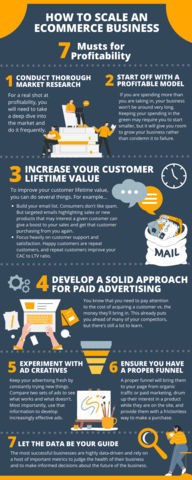
How to Scale an Ecommerce Business: 7 Musts for Profitability
The world of ecommerce has allowed even small businesses to reach a global customer base. But if those businesses want to grow past the small business stage and compete to become one of the next big ecommerce players, they need a strategy in place so they will not only be profitable but also see continued growth. If you own such a business, then this post is for you. We’re going to discuss 7 key factors for how to scale an ecommerce business that you can use to guarantee your own financial security—and the success of your ecommerce company.
7 Key Factors for How to Scale an Ecommerce Business
It’s worth noting that every ecommerce business is unique. Therefore, what helps one scale won’t necessarily work for another. That said, there are some basic steps every ecommerce business should take if they want to scale and increase profitability, which is what we’re going to cover.
Ready? Then let’s dive in…
1) Conduct Thorough Market Research
Very few businesses can thrive without understanding the market they are operating in. At best, you may be able to keep afloat as a small side business. But any chance at growth is dead in the water if you aren't willing to do at least basic market research. For a real shot at profitability, you will need to take a deep dive into the market and do it frequently.
Here are some tips for understanding your market…
- Define a target audience — This is perhaps the most important step in learning how to scale an ecommerce business. Successful businesses use the data available to them to create a fictionalized person that represents their average customer or various customer segments. These customer avatars are then used when creating marketing materials and website copy. By tailoring your products and the tone of your marketing to these avatars, you are targeting your customers as well.
- Survey the competition — Everyone wants to keep ahead of the competition. But you can't beat them if you don't know what they are doing. What features does your competition have that you do not? How do their marketing efforts compare to yours? By understanding what makes your competition successful, and where they are lacking, you can improve your own business to better compete with them.
- Use social media — The loudest voices tend to be those that are either really happy or really angry with a product. For that reason, you shouldn't make rash business decisions based on social media feedback. But what you should do is pay attention to what people on social media are saying on your page, and on the pages of your competition. This will help you determine which way the wind is blowing regarding product offerings and any areas where you can improve your customer experience.
2) Start Off with a Profitable Model
Everyone has heard that it takes money to make money. And it’s true. You need to purchase inventory, advertise to let people know your business exists, pay for web hosting and design, and eventually hire employees. Most of these are ongoing expenses and without them, your business will fail. But spending money to make money must be done intelligently. If you are spending more than you are taking in, your business won't be around very long. Keeping your spending in the green may require you to start smaller, but it will give you room to grow your business rather than condemn it to failure.
3) Increase Your Customer Lifetime Value
There are two very important metrics to consider when learning how to scale an ecommerce business: customer acquisition cost (CAC) and customer lifetime value (LTV). The former describes how much money you must spend to get a new customer to purchase something on your site. The latter describes how much the average customer spends during their lifetime as your customer. These are important metrics because if the first one is higher than the second, you are losing money. If the second one is much higher than the first, you can afford to spend more on advertising.
To improve your customer lifetime value, you can do several things. For example…
- Build your email list. Consumers don't like spam. But targeted emails highlighting sales or new products that may interest a given customer can give a boost to your sales and get that customer purchasing from you again.
- Focus heavily on customer support and satisfaction. Happy customers are repeat customers, and repeat customers improve your CAC to LTV ratio.
4) Develop a Solid Approach for Paid Advertising

To grow your business, you need to grow your customer base. And you can't do that without paid advertising. But without a plan in place, paying for ads is just throwing money away. From the tips above, you already know to create customer avatars that help you target your ads to the right people. You know that you need to pay attention to the cost of acquiring a customer vs. the money they'll bring in. This already puts you ahead of many of your competitors, but there's still a lot to learn.
For more information on effective marketing in the ecommerce sphere, check out one of our other posts: 7 Reasons Why Your E-Commerce Marketing Methods Aren't Working.
5) Experiment with Ad Creatives
Everything about your marketing and sales efforts should be continually evolving. Whatever you are doing right now is most assuredly not the absolute best you could be doing. The only way to find the absolute best is to keep searching for it. And this is especially true with advertising. Even if you had the best ad ever, it would eventually get stale and stop performing as well as it once did.
So, what should you do?
Keep your advertising fresh by constantly trying new things. Compare two sets of ads to see what works and what doesn't. Most importantly, use that information to develop increasingly effective ads.
6) Ensure You Have a Proper Funnel
Your sales/purchase funnel outlines the journey a customer takes from finding out about your company to purchasing a product from you. It essentially guides them through every step until they make a purchase. And if you want to learn how to scale an ecommerce business, you need to be sure you have a true funnel in place.
A proper funnel will bring them to your page from organic traffic or paid marketing, drum up their interest in a product while they are on the site, and provide them with a frictionless way to make a purchase.
The stages of the sales/purchase funnel include…
- Awareness
- Consideration
- Preference
- Purchase
- Loyalty/Advocacy
So, review your own and determine where there may be holes (i.e., areas where prospects are dropping off). Put the time and effort into optimizing each stage of the funnel so you’re providing prospects with valuable content, forging a connection with them, and proving that you have the solution to their problem.
7) Let the Data Be Your Guide
We've talked about the importance of your CAC and LTV metrics. But they are far from the only metrics that you should be paying attention to. The most successful businesses are highly data-driven and rely on a host of important metrics to judge the health of their business and to make informed decisions about the future of the business.
Find yourself a good analytics solution that is designed for scaling an ecommerce business and learn as much as you can about how to set it up and interpret the data that it provides you with.
Takeaway
To recap, here are the 7 key factors for how to scale an ecommerce business and experience greater profitability:
- Conduct thorough market research
- Start off with a profitable model
- Increase your customer lifetime value
- Develop a solid approach for paid advertising
- Experiment with ad creatives
- Ensure you have a proper funnel
- Let the data be your guide
By putting the time and effort into these steps, you can put yourself in a better position for growth and success!
Click the button to take the blog on the go!


